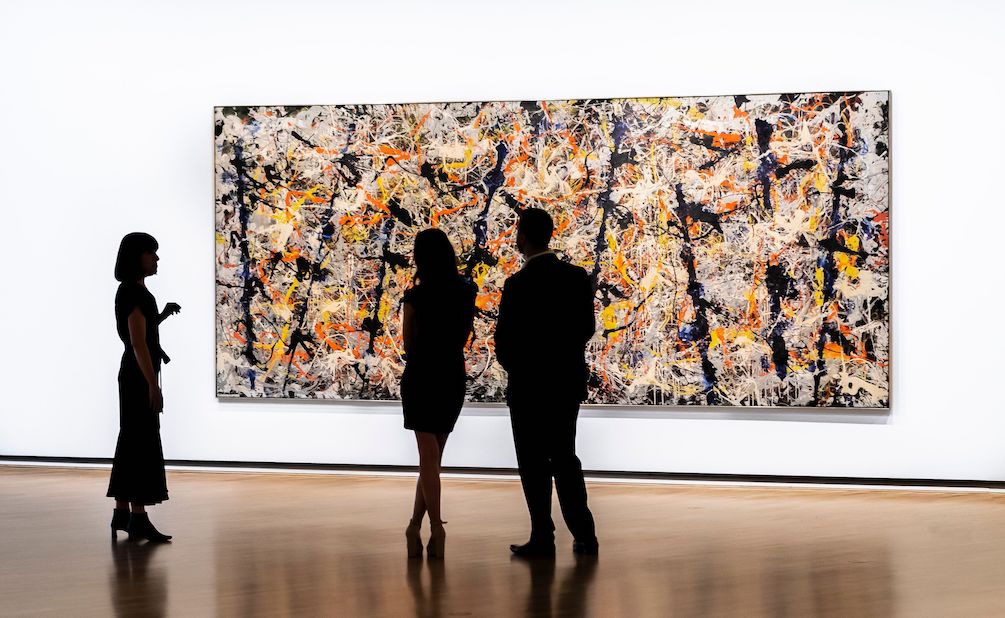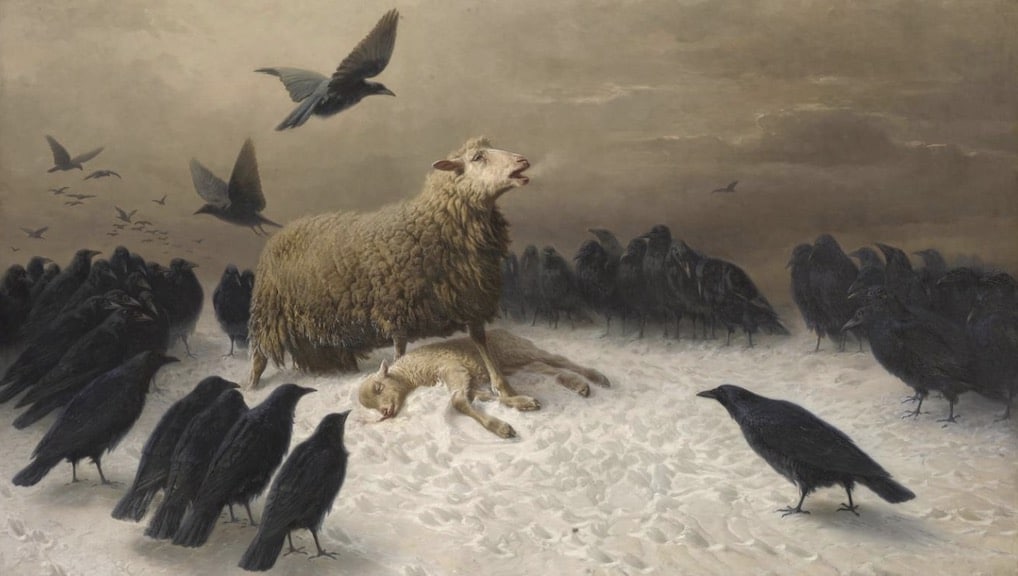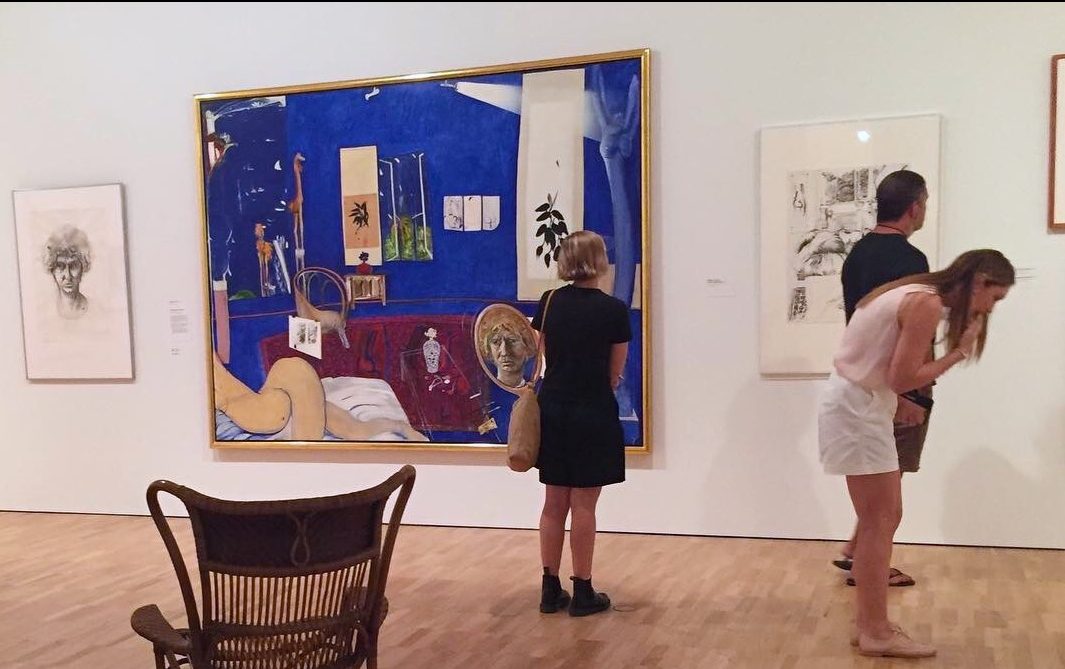In a period when immersive art installations rate high in terms of audience appeal, trends on social media attest that painting still rates higher when it comes to the ‘favourite and most famous’ artworks shared.
In the world of popular opinion, it is not surprising that Leonardo da Vinci’s Mona Lisa, housed within the Louvre Museum (Paris) is the most photographed and posted image on social media, attracting over 2 million hashtags annually according to UK website Money.co.uk.
In real life (IRL) the painting averages 10 million visitors a year, making it the most visited artwork in the world.
Joining the Mona Lisa in the top ten artworks shared on social media are: Gustav Klimt’s The Kiss, Picasso’s Guernica, Van Gogh’s The Starry Night, and rounding off the top five, Grant Wood’s American Gothic.
This lead us to ask: what might be Australia’s ‘most famous’ paintings, at least in the court of popular appeal and awareness?
Australia’s most posted artworks (social media)
Jackson Pollock’s Blue Poles – held in the National Gallery of Australia’s Collection, is perhaps Australia’s most famous artwork (its purchase in 1973 needed the PM to sign off and was the most expensive acquisition in history at the time), however the painting is not by an Australian artist, and is definitely not the most posted when it comes to social media.
A Gallery spokesperson confirmed: ‘James Turrell’s Within without is our most shared work of art on social media.’ Again, an international artist.
Another artwork joining the ranks of most posted is Yayoi Kusama’s The Spirits of the Pumpkins Descended Into the Heavens – first shown at QAGOMA in 2018, then purchased by NGA, and currently touring to the Art Gallery of South Australia (until 30 April 2023). It is clearly one of the most posted artworks in Australia.
But a spokesperson from AGSA confirmed that it is not Kusama’s work but Chiharu Shiota’s installation Absence Embodied that is their most posted artwork from the Collection on social media. Again, not Australian.
The artist ranking highest in Australia via the number of hashtags shared on socials was Patricia Piccinini (37.4K), with her artwork Skywhale, alone driving 5K hashtag impressions.
And in terms of the big ‘pleasers’ online, Australian-born Ron Mueck’s installation Mass, originally commissioned for the 2017 NGV Triennial, was so popular with audiences – both in the flesh and on social media – that it has been rolled out again to welcome visitors back post pandemic (until 15 January 2023). It continues to be a big selfie opportunity.
But all of these are not among Australia’s most famous artworks.
What is Australia’s most ‘famous’ artwork?
Popularity is a multi-headed monster when the word ‘fame’ comes into play. But when it comes to trying to work out what is Australia’s most ‘famous’ artwork, many will turn to household names such as Tom Roberts, Arthur Boyd, Arthur Streeton and Margaret Olley.
All of these artists painted well before the internet was conceived, let alone social media. They also sit outside adjustments made within collecting and museum circles in recent decades, such as gender equity, diversity and First Nations narratives. And yet these endure as our most ‘famous’ artworks.
These were the artworks that hit our top ten for their popularist lens:
- Frederick McCubbin’s On the Wallaby Track (1896), Art Gallery of NSW, depicting a woman with her child on her lap and a man boiling a billy for tea – used in a television advertisement for tea, adding to its popular imprint.
- Sidney Nolan’s Ned Kelly series – across various venues, but with 25 key works held by NGA – is much loved and visually a signature of Australian art for popular audiences.
- Brett Whiteley’s Self portrait in the studio (1976), AGNSW, and almost interchangeable with his The Balcony 2 (1975).
- Tom Roberts’ Shearing the Rams (1890) at the NGV.
- Grace Cossington Smith’s The Bridge in Curve (1930), also part of the NGV Collection.
- John Brack’s Collins St., 5 p.m (1955) described as a classic masterpiece. It was chosen as the most popular piece in the National Gallery of Victoria’s collection in 2011.
- Albert Namatjira’s Central Australian Landscape (1945), one of many paintings of his beloved Country. For many, his paintings have come to encapsulate central Australia.
- Anwerlarr Anganenty, Big Yam Dreaming (1995) by Emily Kame Kngwarreye – a whopping three by nine metre painting in the NGV. It was completed towards the end of her career.
- Rosalie Gascoigne’s Metropolis (1999), an iconic work that defined her use of road signs, held in the AGNSW collection.
The paintings that drive foot traffic
What we have learnt over the pandemic is that the experience of art ‘in the flesh’ wins hands down over the digital experience.
Jackson Pollock’s aforementioned Blue Poles is the most visited artwork at the NGA. Before the bushfires and the pandemic, 858,074 people visited the NGA (2018-2019), and it would be safe to say most of them stood in front Pollock’s epic work.

Also top of a visit to the NGA is Lucian Freud’s After Cézanne and David Hockney’s A Bigger Grand Canyon.
For AGSA, Francis Bacon’s Study for Figure IV is reported to be the gallery’s ‘most famous’ painting in the collection (in terms of public awareness) but the painting everyone flocks to stand in front of is Tom Roberts’ A break away! and JW Waterhouse’s Circe Invidiosa – one that surprised us.
Painted in 1892 in London, Circe Invidiosa was acquired in 1892, and shows how those foundational bequests that frame out our state collections are the paintings many of us have grown up with, love, and repeatedly return to view.
Similarly, another surprise in our research is a work by August Friedrich Albrecht Schenck aka ‘Anguish’s ‘sad sheep painting’ as it is colloquially known, at the NGV. It has twice been voted one of the NGV’s most popular works – first in 1906 and then again a century later in 2011, trumping other favourites such as Max Dupain’s Sunbaker, Katsushika Hokusai’s The great wave off Kanagawa, Picasso’s Weeping Woman and Frederick McCubbin’s triptych, The Pioneer.
What triggers popularity? Anguish is an interesting case in point – a 140-year-old oil painting that is decidedly odd in terms of subject matter, by an artist whom history has largely forgotten.

While in the past it was allegorical in nature (Anguish was one of the NGV’s earliest acquisitions) today it taps into contemporary narratives around the environment, animal liberation, empathy, power, and even gender. August Schenck even has a fan club on Facebook.
It may not be Michelangelo’s Sistine Chapel ceiling, the Creation of Man, with five million visitors a year, but it does demonstrate that art is enduring; that art connects; and that you can never underestimate the power of the audience’s opinion – and sentiment.





